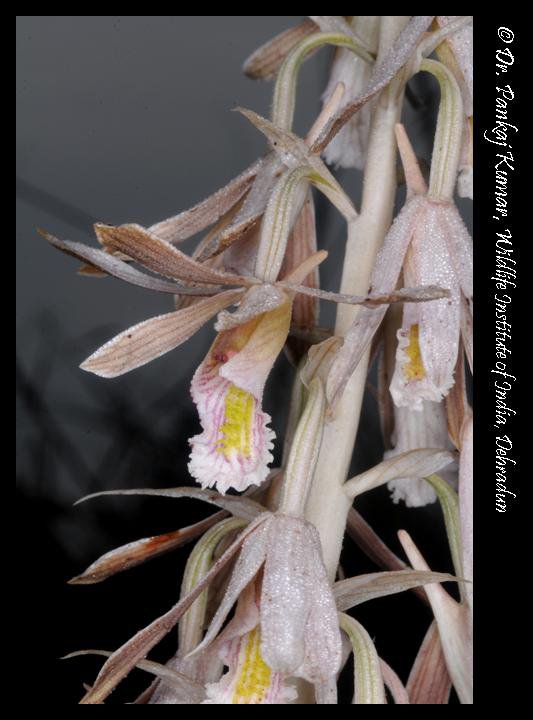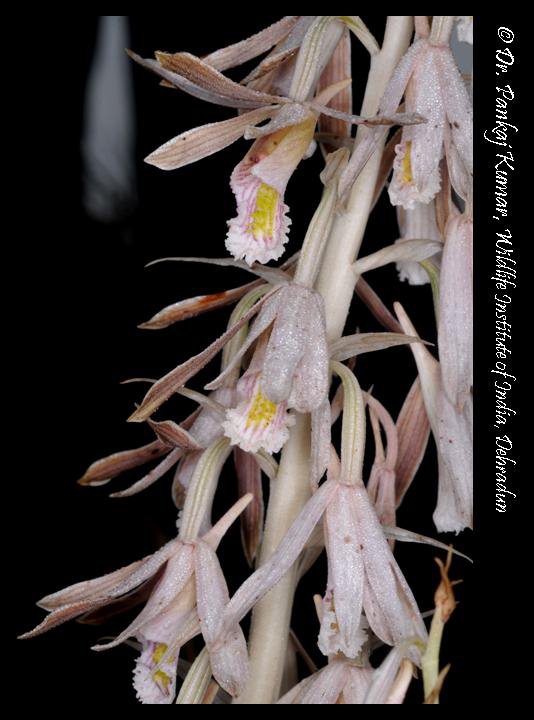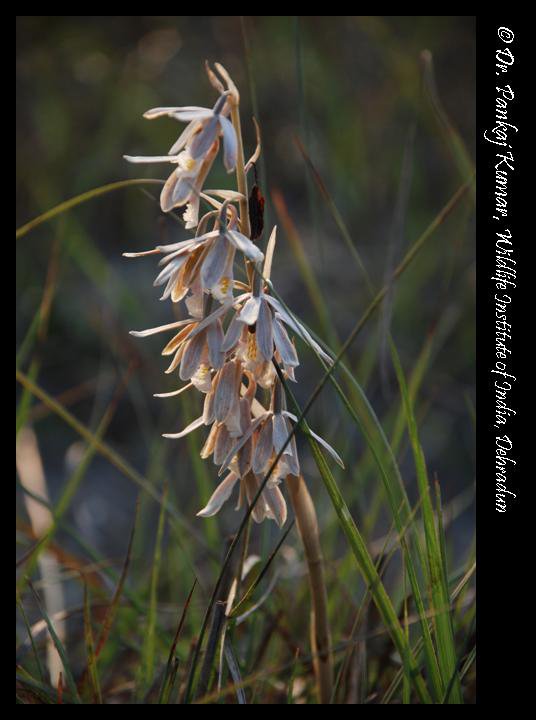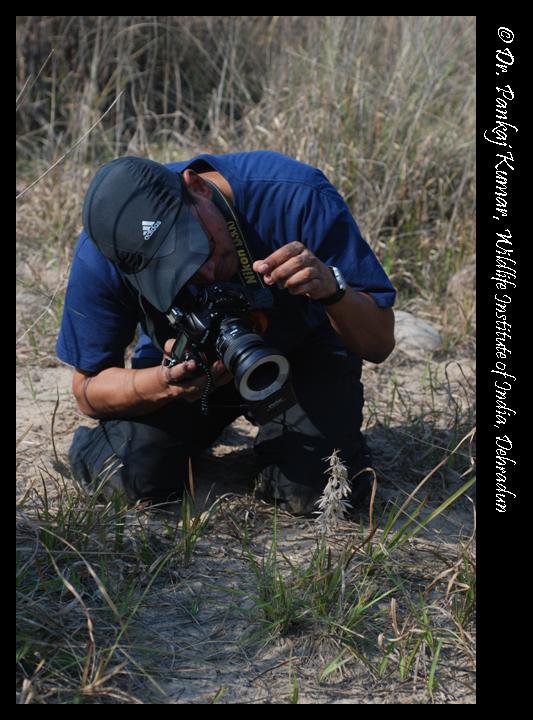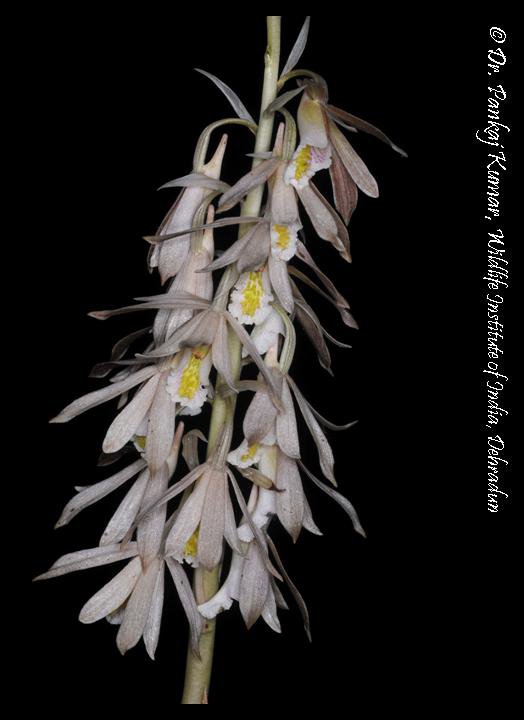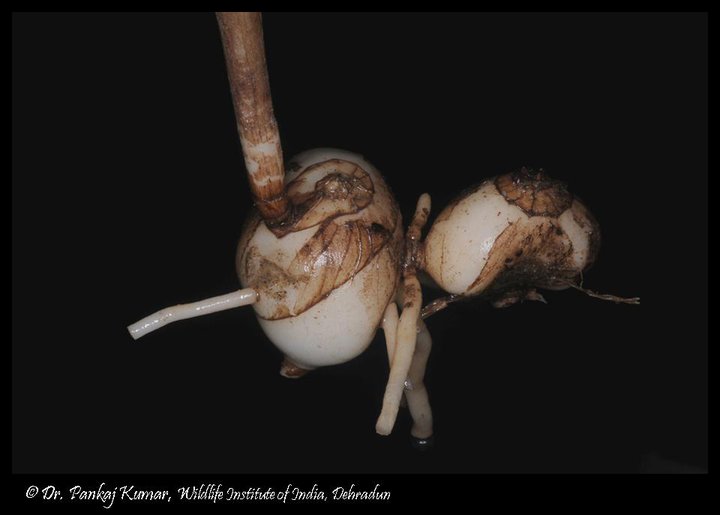|
Eulophia dabia (D.Don) Hochr., Bull. New York Bot. Gard. 6: 270 1910. (Syn: Bletia dabia D.Don ….);
.
Eulophia dabia (D.Don) Hochr.: On the discovery of the dubious Eulophia: Eulophia dabia (D.Don) Hochr., Bull. New York Bot. Gard. 6: 270 (1910).
Synonyms: Bletia dabia D.Don, Prodr. Fl. Nepal.: 30 (1825). Limodorum dabia (D.Don) Buch.-Ham. ex D.Don, Prodr. Fl. Nepal.: 30 (1825). Graphorkis dabia (D.Don) Kuntze, Revis. Gen. Pl. 2: 662 (1891). Limodorum ramentaceum Roxb., Fl. Ind. ed. 1832, 3: 467 (1832). Eulophia campestris Wall. ex Lindl., Gen. Sp. Orchid. Pl.: 185 (1833). Eulophia ramentacea (Roxb.) Lindl., Gen. Sp. Orchid. Pl.: 185 (1833). Eulophia rupestris Wall. ex Lindl., Gen. Sp. Orchid. Pl.: 185 (1833). Geodorum ramentaceum (Roxb.) Voigt, Hort. Suburb. Calcutt.: 628 (1845). Eulophia hemileuca Lindl., J. Proc. Linn. Soc., Bot. 3: 25 (1859). Graphorkis campestris (Wall. ex Lindl.) Kuntze, Revis. Gen. Pl. 2: 662 (1891). Graphorkis rupestris (Wall. ex Lindl.) Kuntze, Revis. Gen. Pl. 2: 882 (1891). Eulophia faberi Rolfe, Bull. Misc. Inform. Kew 1896: 198 (1896). Limodorum turkestanicum Litv., Trudy Bot. Muz. Imp. Akad. Nauk 1: 18 (1902). Eulophia hormusjii Duthie, Ann. Roy. Bot. Gard. (Calcutta) 9(2): 125 (1906). Eulophia turkestanica (Litv.) Schltr., Repert. Spec. Nov. Regni Veg. 12: 374 (1913). Family: Orchidaceae
Location: Rajaji National Park, Uttarakhand Date: 12.03.2011 – 19.03.2011 (on multiple trips) This is supposed to be highly medicinal plant and it is assumed to be the original Salem Misri, but now a days becoming too rare. I was authorized to collect the plant by forest department for research purpose also because I work with MoEF on Orchids, and hence I was able to get down the vehicle with my team inside the National Park, which is otherwise illegal, so please dont try this in any park it is highly restricted. Rajaji is famous for Elephants along with Tiger and Leopard which may attack. On one trip, I even accompanied the PCCF (Uttarakhand), Director (Rajaji NP) and my boss … just to show them this beautiful orchid.
Finding this orchid was surely an achievement. – Protologue of the same attached. – Salam Panja, salam Misri and 8 astavarga medicines of ayurveda are extremly usefull in many ayurvedic preparations. Many of them are from Orchidaceae family. Any programme to conserve and propagate them going on or not ? – During my last lecture during my Sikkim trip, one of my suggestion was to conserve these high value medicinal plants (around 15 from western HImalaya (in the wild, by conserving their environment and at the same time checking their collection from wild by these high profile chawanparash makers and even my suggestions were one of those which were later sent to the ministry or agriculture as well as environment and Forests.
Synonyms: I knew it would be double century. Congrats … Thanks a lot sir. PICTURE ABHI BAKI HAI :), just that I dont have time to spare. Lets hope I can post more. Thanks a lot to you and to every one for the trust and encouragements. Beautiful orchid, one another from Uttarakhand. Seen but yet to be photographed. It must be a subtropical one. AND DOUBLE CENTURY…PICTURE ABHI BAKI HAI ! Great work and dedication … This was found in the Shivaliks in Rajaji National Park. I was given special permission to go in, collect and identify. . 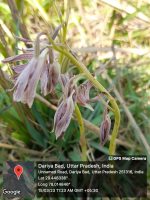   ld please: 3 high res. images. ID please for this ground orchid.
Does it seem like Eulophia sp?
DATE OF COLLECTION: 15.03.2023 LOCATION: NEAR PADDY FIELD, DARIYABAD, UTTAR PRADESH.
SOLO HERB WITHOUT LEAVES. Elevation: 240m / 787 feet.
Close to Eulophia dabia (D.Don) Hochr. I was having doubts about E.dabia.
Thank you all, I will check it again.
I am also 100 % not sure ! Just looks like that ! mostly Eulophia dabia Thank you, …, for its lip structure and mid-lobe doubt persist. Thankyou very much to all, after going through your opinions, dissection and study now I may say it as E.dabia. Would be keen to check the dissection. I see in one of your images that petals and sepals are bend backwards. Is it true? . References:
|
Disclaimer
1. For any mistake in identification or for becoming efloraofindia e-group member (for contributing towards building of efloraofindia or otherwise), pl. mail to indiantreepix@googlegroups.com or itpmods@googlegroups.com
2. For better viewing of species’ pages, colour scheme & formatting is being followed as: Description of the species, Details of other flora species on the same page, Uses/ harms, Distribution, Abundance/ Location/ Flowering time & date, Habit & habitat, Etymology & pronunciation, Other interesting information, stories etc., Others, Botanical names, Common names, Main point of discussion below, Discussion about Botanical names.
Navigation
- Award for eFloraofIndia
- Colour scheme & formatting
- Copyrights, Permissions, Citations
- eFloraofIndia appreciated
- Names of Plants in India site
- Flowersofindia site
- Posting Guidelines
- For members’ information
- Logo, Tagline, Acronym
- Volunteers required
- ‘Pitamah’ of eFloraofIndia
- ‘अजेय’ ‘Ajey’ of eFloraofIndia
- ‘Saarthi’ ‘सारथि’ of eFloraofIndia
- ‘Jewel’ of eFloraofIndia
- ‘Grassman’ of eFloraofIndia

